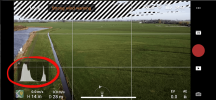Hi all,
New Air 2 pilot here, I’ve had a very basic drone in the past, but totally new to any kind of manual photography. Seeking some tips for choosing the proper balance between ISO, shutter speed, and ND filters, to get the best shots.
I’ve read up on what each of the variables are and what they do, as well as aperture, which I believe is fixed on the Air 2.
For my first flight, auto mode was severely overexposing elements of the shot, so I switched to manual mode and changed shutter speed accordingly. Second flight, I added a filter (it was mid day in a bright/snowy area), and then tweaked shutter speed and ISO to find a good lighting balance. So, my point is, I think I understand the basics of how to balance the filters, shutter speed, and ISO, just to achieve visibility. But, I’m sure there are finer points I’m unaware of, in general, and specifically in relation to aerial photography. Wondering if there are, for example, situations where it would be more advantageous to use a faster shutter speed and higher ISO, vs a slower shutter speed and lower ISO, and where proper filter selection comes in, etc.
Any advice or links to a good guide are greatly appreciated!
New Air 2 pilot here, I’ve had a very basic drone in the past, but totally new to any kind of manual photography. Seeking some tips for choosing the proper balance between ISO, shutter speed, and ND filters, to get the best shots.
I’ve read up on what each of the variables are and what they do, as well as aperture, which I believe is fixed on the Air 2.
For my first flight, auto mode was severely overexposing elements of the shot, so I switched to manual mode and changed shutter speed accordingly. Second flight, I added a filter (it was mid day in a bright/snowy area), and then tweaked shutter speed and ISO to find a good lighting balance. So, my point is, I think I understand the basics of how to balance the filters, shutter speed, and ISO, just to achieve visibility. But, I’m sure there are finer points I’m unaware of, in general, and specifically in relation to aerial photography. Wondering if there are, for example, situations where it would be more advantageous to use a faster shutter speed and higher ISO, vs a slower shutter speed and lower ISO, and where proper filter selection comes in, etc.
Any advice or links to a good guide are greatly appreciated!










